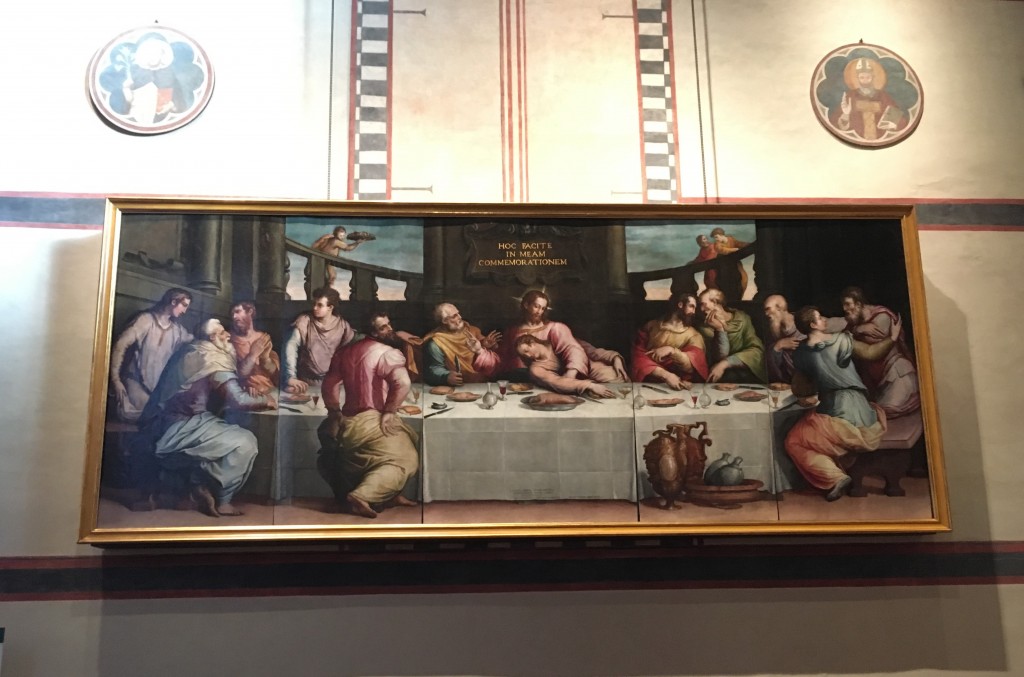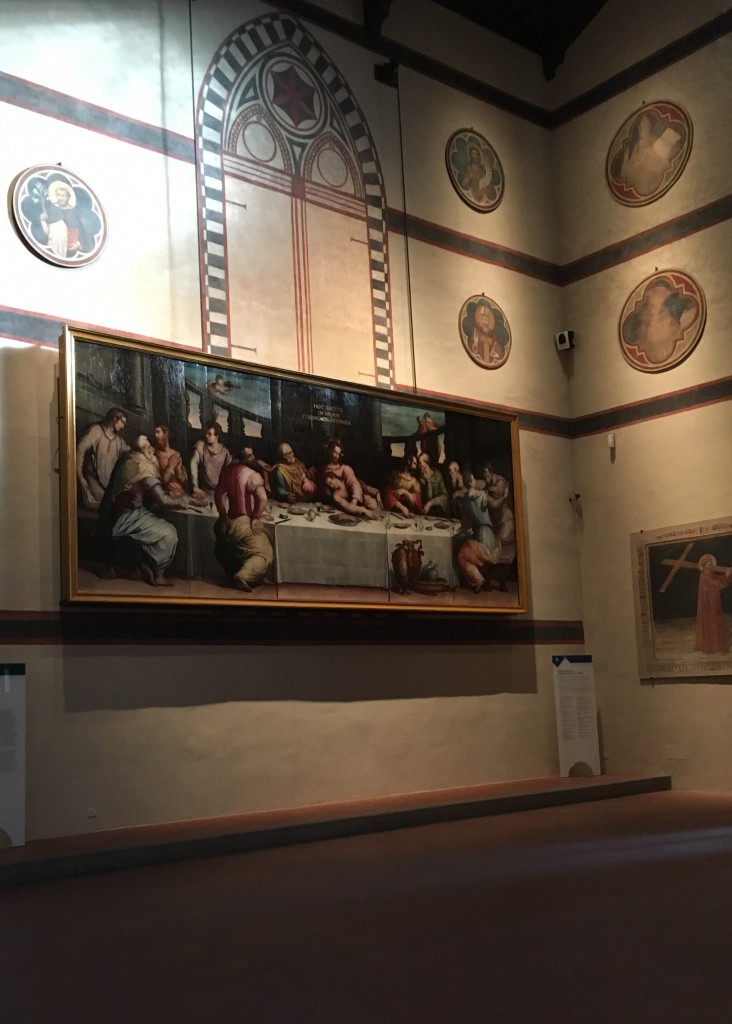
Museo dell’Opera di Santa Croce, Firenze
Dal 4 novembre 2016
Di Tania Mio Bertolo (Università degli Studi di Firenze)
Erano trascorsi meno di dieci anni da quando la tavola lignea dell’Ultima Cena di Giorgio Vasari era stata trasferita dall’antico refettorio del convento di Santa Croce ad una delle nuove sale del Museo dello stesso complesso monumentale, allorchè l’Arno esondò ed il dipinto rimase dodici ore sommerso da acqua e fango. Era il novembre del 1966 ed il Museo di Santa Croce, nel quale l’acqua raggiunse cinque metri e due centimetri d’altezza, fu definito “l’epicentro del disastro”. Il museo riaprì soltanto nel 1975 e da allora ospita, tra gli altri esemplari storico artistici del complesso, le opere restaurate a seguito dell’alluvione. Già l’anno successivo alla riapertura fu restituito al pubblico il Crocifisso di Cimabue, assunto a simbolo tra le vittime artistiche dell’alluvione per la perdita del 60% della superficie pittorica; ma vanno ricordati anche i restauri ai quali furono sottopposti il grande affresco realizzato da Taddeo Gaddi comprendente l’Ultima Cena e l’Albero della Vita, staccato per l’occasione e successivamente ricollocato nella posizione originaria, la Deposizione dalla Croce di Francesco Salviati e la Discesa di Cristo al Limbo di Bronzino (ora entrambi nella Cappella Medici), e molti altri ancora. A distanza di cinquant’anni esatti dall’alluvione, anche il cenacolo vasariano è stato restituito al pubblico.
Realizzata nel 1546 per il refettorio dell’antico monastero delle Murate, la tavola lignea vasariana fa parte dell’arredo monumentale del complesso di Santa Croce dal 1815, pur avendo ivi subito svariati riposizionamenti. A seguito dell’alluvione l’opera fu messa in sicurezza nei depositi cittadini delle soprintendenze, e fu sottoposta alle operazioni di restauro soltanto a partire dal 2006. Dal novembre del 2016 il dipinto è nuovamente visibile al pubblico con una nuova cornice, sorretto da un sistema di contrappesi capace di sollevarlo in eventuali situazioni d’emergenza e dotato di una scatola di climatizzazione sul tergo.
Collocata nella parete nord dell’ex cenacolo del complesso, ambiente che rappresenta il cuore del Museo di Santa Croce, l’Ultima Cena di Vasari è presentata al pubblico corredata di quanto quest’ultimo possa necessitare per comprenderne le vicende storiche: dai piccoli pannelli di testo di carattere storico descrittivo; allo schermo interattivo che fornisce al visitatore molteplici percorsi di approfondimento testuali supportati da immagini ad alta risoluzione, radiografie e riflettografie; al documentario che testimonia ogni fase del recupero del dipinto. Benchè ospitato nella sala adiacente il refettorio, tale filmato è proiettato strategicamente su una delle pareti vicine al passaggio di collegamento tra i due ambienti: questa intelligente scelta museografica permette al visitatore di seguire il documentario pur godendo contemporaneamente della vista dell’opera vasariana. E le straordinarie dimensioni di quest’ultima, i suoi vivaci colori e le sue corpulenti figure dalle pose manieristiche colpiscono ed affascinano lo sguardo di chi va cercando un commosso equilibrio tra ciò che è stato perduto per sempre e ciò che è stato restituito.
La tavola vasariana, va detto, fatica a dialogare stilisticamente con le altre opere ospitate nel refettorio tra le quali il bronzo dorato del San Ludovico di Tolosa di Donatello, il già citato affresco di Taddeo Gaddi ed alcuni frammenti di Andrea Orcagna. Tuttavia ciascuna di esse ha un legame storico con il complesso di Santa Croce, e molte di esse hanno ragione di essere messe a confronto come testimonianza di eccellente operazione di restauro e rinascita dopo l’alluvione del ‘66.

Translation by Rachyl Grussing (Istituto Lorenzo de’Medici)
It has been less than ten years since the wooden dinner table of Giorgio Vasari’s Last Supper had been transferred from the ancient refectory of the convent of Santa Croce to one of the new halls of the Museum of the same monumental complex, after the Arno exhumed and painted it for twelve hours with water and mud. It was in November of 1966, and the Museum of Santa Croce, in which the water reached five meters and two centimeters high, was termed, ‘the epicenter of the disaster’. The museum of was only reopened in 1975 and since then has hosted, among other artistic examples from the complex, works restored after the flood. Already in the year following the re-opening to the public, the Crucifix by Cimabue, a symbol of the artistic flood victims for the loss of 60% of its pictorial surface, was returned to the public; but the restorations which should be mentioned are the great fresco realized by Taddeo Gaddi, including the Last Supper and the Tree of Life, which were removed for the occasion and later relocated to their original position, the Deposition from the Cross by Francesco Salviati and the Christ’s Descent to the Limbo by Bronzino (now both in the Medici Chapel), and many others. A distance of fifty years exactly from the flood, even Vasari’s Upper Room was returned to the public.
Realized in 1546 for the refectory of the ancient Murate monastery, the Vasarian wooden table is part of the monumental furnishings of the Santa Croce complex since 1815, although there have been several repositionings. Following the flood, the work was safely secured in the town hall of the Superintendents, and was only restored in 2006. From November 2016, the painting is again visible to the public with a new frame, supported by a counterweight system capable of lifting it in any emergency situation, and equipped with air conditioning box on the floor.
Located in the north part of the former cenacle of the complex, the setting that represents the heart of the Museum of Santa Croce, the Last Supper by Vasari is presented to the public as well as what the latter may need to understand historical events: small panels of descriptive historical text to interactive screens that provides the visitor with multiple textual supports, enhanced by high resolution images, radiographs and reflections, to the documentary that witnesses every stage of the paintings recovery. Although housed in the room adjacent to the refectory, the film is projected strategically on one of the walls close to the linking passage between the two rooms: this intelligent museological choice allows the visitors to follow the documentary while simultaneously enjoying the view of Vasari’s work. And the extraordinary dimensions of the latter, its vibrant colors and its corpulent figures with manneristic poses affect and fascinate the minds of those who are looking for the hard balance between what has been lost forever and what has been returned.
The Vasarian table, it must be said, struggles to stylistically dialogue with the other works housed in the refectory, among which are the golden bronze of St. Ludovico in Toulouse by Donatello, the already mentioned fresco by Taddeo Gaddi, and some fragments by Andrea Orcagna. However, each of them has some historical link with the Holy Cross complex, and many of them are right to be compared as evidence of an excellent restoration and rebirth operation after the flood of ‘66.